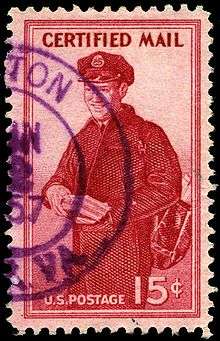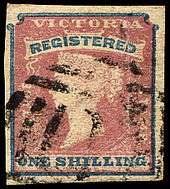Registered mail

Registered mail is a mail service offered by postal services in many countries, which allows the sender proof of mailing via a mailing receipt and, upon request, electronic verification that an article was delivered or that a delivery attempt was made. Depending on the country, additional services may also be available, such as a chain of custody, where the posted item has its details recorded in a register to enable its location to be tracked, sometimes with added insurance to cover loss. The name of this service varies from country to country, and postal services in some countries offer more than one level of service under different names (e.g., "certified mail" and "registered mail" in the U.S.). See the country-specific information below for details.
Background
Traditionally, registered mail was a manual process which gave rise to a great variety of distinctive postal markings, like handstamps, and usage of registration labels.[1] Many countries have issued special postal stationery and postage stamps for registered mail. Earlier similar services were known as Money Letters. Today, however, the registration process is largely computerized with barcode registration labels replacing the traditional analog labels having only a printed serial number.
Generally, the item is pre-paid with the normal postage rate and an additional charge known as a registration fee. Upon payment of this fee the sender is given a receipt, and (usually) a unique numbered registration label is affixed to the letter. As the letter travels from post office to post office and through any sorting office, it has to be signed for on a ledger. This process is completed when the letter is delivered and the receiver signs for the item. With computerization and barcode technology, much of the logging once done manually has become simpler and leads to greater options for the sender and receiver alike to access the status of their shipment via the internet. Many postal authorities provide tracing information for registered items on their website.
Internationally, the use of registered mail requires labels with a 13-digit reference number and corresponding barcode. The first two letters indicate registration (usually "RR") while the last 2 letters usually represent the country where the registered item was posted. E.g., RR913282511SG indicating Singapore, RB5584847749CN indicating China or RR123456785KR indicating Korea.[2]
History
In the turbulent political and religious climate during the reign of Mary Tudor is found the earliest reference to a registration system in the Kingdom of England in London in July 1556 whereby: that the poste between this and the Northe should eche of them keepe a booke and entrye of every letter that he shall receive, the tyme of the deliverie thereof unto his hands with the parties names that shall bring it unto him, whose handes he shall also take to his booke, witnessing the same note to be trewe.[3] This was likely for state security rather than mail security.[4] In 1603, another Order of Council was made whereby all letters had to be recorded.[3] This system was in effect a registration system although it applied to all items sent via the post.
William Dockwra's 1680s London Penny Post also recorded all details on letters accepted for onward transmission[3] but unlike the general post office, gave compensation for losses.
The registration of letters as known today was introduced in 1841 in Great Britain. The letter had to be enclosed within a large sheet of green paper. The green sheet was addressed to the Post Office where the recipient lived. The green sheet was then used as a receipt and was returned to the office of origin after delivery. On 1 July 1858 the green sheet was replaced by a green silk ribbon and shortly afterwards by a green linen tape. In 1870 the tape was replaced by green string. On the introduction of postal stationery registration envelopes in 1878 the string was replaced by printed blue crossed lines. The blue crossed lines have survived on registered letters to the present day.[5]
By country
United Kingdom
Since 1998, the Special Delivery service has been the only registered service offered by Royal Mail, after the old-style Registered Letter service was discontinued.[6]
United States

The United States Postal Service offers two distinct services called Certified Mail and Registered Mail.
Certified Mail in the United States
Certified Mail allows the sender proof of mailing via a mailing receipt and, upon request electronic verification that an article was delivered or that a delivery attempt was made.[7] Some in-transit tracking and delivery confirmation information may be provided, but there is no formal chain of custody. Certified Mail is only available for Priority Mail and First Class Mail[8] letters mailed within the United States and its territories (including APOs and FPOs).[9] Each piece of Certified Mail is assigned a unique label number which serves as an official record of mailing of the item by the Postal Service.
U.S. certified mail began in 1955 after the idea was originated by Assistant U.S. Postmaster General Joseph Cooper.[10] It is also acceptable to send U.S. Government classified information at the Confidential level using the Certified Mail service. Certified mail may be selected for many reasons, not just for important business mailings. It is used by anyone who needs or wishes to provide a tracking number to the receiver as proof of mailing. It also allows the receiver to track their package/envelope through the online system at usps.com using the unique tracking number provided by the mailer.[11]
Certified Mail can be done either with or without "return receipt requested", often called "RRR", which costs an additional fee. The return receipt is a green postcard-sized paper that is mailed back to the sender by the post office upon receipt by the addressee as proof of delivery. Today the USPS new Return Receipt Electronic (RRE) provides electronic proof of delivery information. When the letter reaches its final delivery destination the letter carrier captures the signature of the person that accepts the letter and the information is electronically stored. As indicated on the return receipt card, either the addressee or the addressee's "agent" may sign for the document. [11]
Registered Mail in the United States
Registered mail service is offered by the United States Postal Service as an extra service for First Class or Priority Mail shipments. Registered Mail provides end-to-end security in locked containers. Registered Mail custody records are maintained, but are not normally provided to the customer, unless a claim is filed.[11]
In the United States, registered mail may be used to send classified material up to the Secret collateral level.[12]
Canada
Canada Post's Registered Mail service provides the sender with a mailing receipt, and upon delivery of the item, with the delivery date and a copy of the signature of the addressee or the addressee's representative. Registered Mail may include lettermail, documents, valuables, and literature for the blind.[13]
Israel
Israel Post's Registed Mail service (Hebrew: דֹּאַר רָשׁוּם, doar rashum) provides the sender with a mailing receipt, and upon delivery of the item, the addresee must sign in order to obtain the item. The sender can monitor the item until its delivery, for items intended for 84 cities in Israel. A confirmation of delivery is sent to the sender for an additional fee. Registered Mail may include letters, postcards and printed matter.[14]
On 25 November 2015 a perliminary reading that forces the sender to mention his name on an item sent via registered mail, passed.[15] According to the press, the major opposition to this bill is the Courts Administration that sends most of its mail via registered mail with a confirmation of delivery, and claims that knowing the identity of the sender, many of their addressees will choose not to accept the items, thus delaying the legal proceedings they are a party to.[16]
Gallery
 First registered postage stamp of Victoria (Australia) 1865, 1 shilling
First registered postage stamp of Victoria (Australia) 1865, 1 shilling United States of Colombia 1865, 5c registration stamp 'A' (Anotacion)
United States of Colombia 1865, 5c registration stamp 'A' (Anotacion) Colombia 1889, 10c registration stamp
Colombia 1889, 10c registration stamp Antioquia 1902, 10c registration stamp
Antioquia 1902, 10c registration stamp Tuva 1933, 1 kopeck registration stamp
Tuva 1933, 1 kopeck registration stamp Yugoslavia 2002, registration stamp
Yugoslavia 2002, registration stamp
See also
References and sources
Notes
- ↑ Mackay (1982), pp. 154–179, 296–366
- ↑ "S10c-5 Identification of postal items - Part C: 13 character identifier for special letter products" (doc). Universal Postal Union. 2004-02-03. Retrieved 2009-12-15.
- 1 2 3 Joyce (1893), p. 234
- ↑ Mackay (1982), p 7
- ↑ Huggins, Alan Keith (1970). British postal stationery : a priced handbook of the postal stationery of Great Britain. London: Great Britain Philatelic Society. p. 102. ISBN 0-901421-01-4.
- ↑ Royal Mail Special Delivery from 1971 by Austin Davis, Great Britain Philatelic Society, 2013. Retrieved 7 October 2013. Archived here.
- ↑ USPS. "Receipt for Certified Mail". usps.com. Retrieved 16 July 2014.
- ↑ USPS: Eligibility for Certified Mail
- ↑ Available USPS Destinations for Certified Mail
- ↑ "Publication 100 - The United States Postal Service - An American History 1775 - 2006". USPS.com. United States Postal Service. November 2012. Retrieved 2014-03-18.
- 1 2 3 USPS FAQs
- ↑ "30 CFR 2.28" (pdf). 2007. Retrieved 2010-04-08.
- ↑ . 2015 https://www.canadapost.ca/tools/pg/manual/pgregister-e.asp. Retrieved 2015-05-09. Missing or empty
|title=(help) - ↑ . 2016 http://www.israelpost.co.il/postshirut.nsf/misparide/216?OpenDocument. Retrieved 2016-07-06. Missing or empty
|title=(help) - ↑ . 2016 http://main.knesset.gov.il/News/PressReleases/Pages/press251115-l0.aspx. Retrieved 2016-07-06. Missing or empty
|title=(help) - ↑ . 2016 http://www.yediot.co.il/articles/0,7340,L-4824696,00.html. Retrieved 2016-07-06. Missing or empty
|title=(help)
Sources
- Joyce, Herbert (1893). The History of the Post Office from Its Establishment Down to 1836. London: Richard Bentley & Son. p. 460.
- Mackay, James A. (1982). Registered Mail of the British Isles. Dumfries, Scotland: James A. Mackay. p. 395.
Further reading
| Wikimedia Commons has media related to Registered mail. |
- Holyoake, Alan. (2012) Great Britain secured delivery of mail 1450-1862. The Great Britain Philatelic Society.
